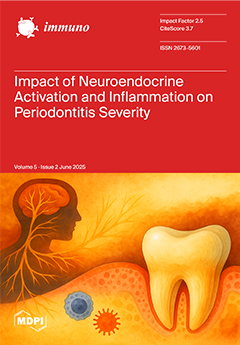Background: A novel and highly effective strategy for tumor immunotherapy involves enhancing host immune responses against tumors through the blockade of checkpoint molecules. The most common toxicities associated with checkpoint blockade therapies include autoimmune damage to various organs. Purpose: This study aims to investigate hematological markers derived from complete blood counts (CBCs)—including the neutrophil-to-lymphocyte ratio (NLR), platelet-to-lymphocyte ratio (PLR), derived neutrophil-to-lymphocyte ratio (dNLR), white blood cell-to-hemoglobin ratio (WHR), neutrophils, lymphocytes, platelets, hemoglobin, red blood cell (RBC) count, neutrophil-to-RBC ratio (NRR), and neutrophil-to-hemoglobin ratio (NHR)—as potential prognostic biomarkers for the early identification of hypothyroidism in patients receiving PD-1 or PD-1/CTLA-4 immune checkpoint inhibitors. Materials and Methods: A prospective observational study was conducted on 44 patients with stage III-IV solid tumors treated with immune checkpoint (PD-1 or PD-1/CTLA-4) inhibitors. Thyroid function tests and CBC-derived biomarkers were collected at baseline, before immunotherapy. In the immunotherapy cohort, 15 of the 44 patients developed immune-related hypothyroidism, defined as overt autoimmune thyroiditis (TSH > 4.0, FT4 < 12, and anti-TPO antibodies > 30 IU/mL and/or anti-TG antibodies > 95 IU/mL) (Group 1). In comparison, 29 patients maintained normal thyroid function (Group 2). The control group comprised 14 age- and sex-matched healthy volunteers (Group 3). Statistical analyses were performed using analysis of variance (ANOVA) to compare blood parameters among the three groups (Group 1, Group 2, and Group 3) before treatment, with statistical significance set at a
p-value < 0.05. Receiver operating characteristic (ROC) curve analysis was conducted to evaluate the diagnostic power of the potential prognostic biomarkers areas. The area under the curve (AUC), sensitivity, and specificity were calculated for the 44 immunotherapy patients. Results: The PLR was significantly higher (262.25 ± 162.95), while WBCs-neutrophils, the WHR, the NRR, the NHR, WBCs, neutrophils, and lymphocytes were lower (2.07 ± 0.66, 0.54 ± 0.19, 0.96 ± 0.28, 0.36 ± 0.14, 6.36 ± 2.07, 4.29 ± 1.55, and 1.23 ± 0.41, respectively) at baseline in Group 1 in comparison to Group 2. ROC curve analysis revealed that the areas under the curve (AUC) for WBCs, neutrophils, lymphocytes, WBCs-neutrophils, the PLR, the WHR, the NRR, and the NHR were 0.9, 0.87, 0.83, 0.85, 0.84, 0.92, 0.89, and 0.87, respectively. These values exceeded the threshold, indicating the high prognostic potential of each marker. Conclusions: Lower baseline levels of WBCs-neutrophils, the WHR, the NRR, the NHR, WBCs, neutrophils, and lymphocytes, along with a higher PLR, were associated with an increased risk of hypothyroidism in patients receiving PD-1 or PD-1/CTLA-4 inhibitors. These CBC-derived biomarkers represent simple, accessible, and potentially useful tools for predicting hypothyroidism in cancer patients undergoing immunotherapy. Further studies in bigger cohorts are needed to validate our findings.
Full article





